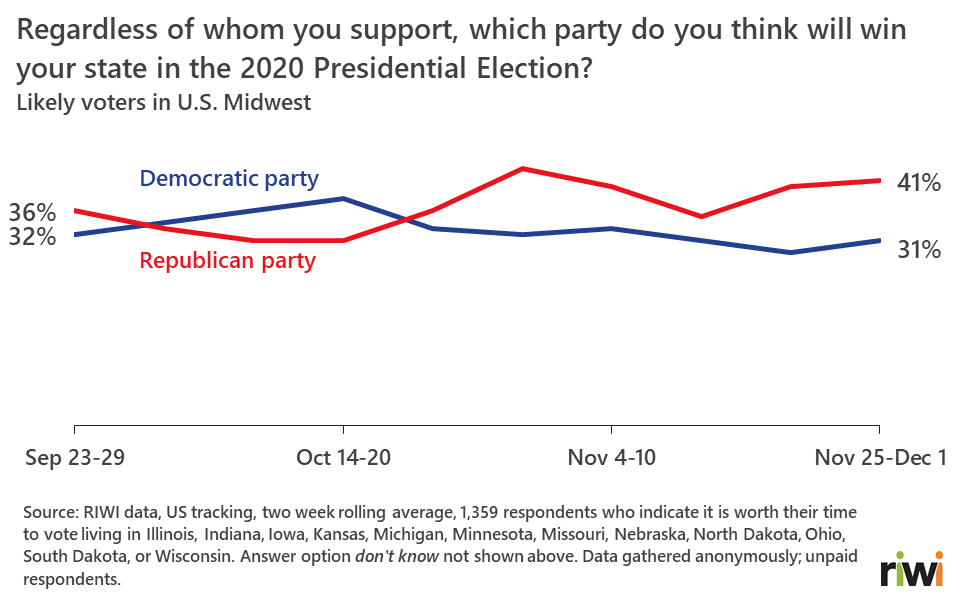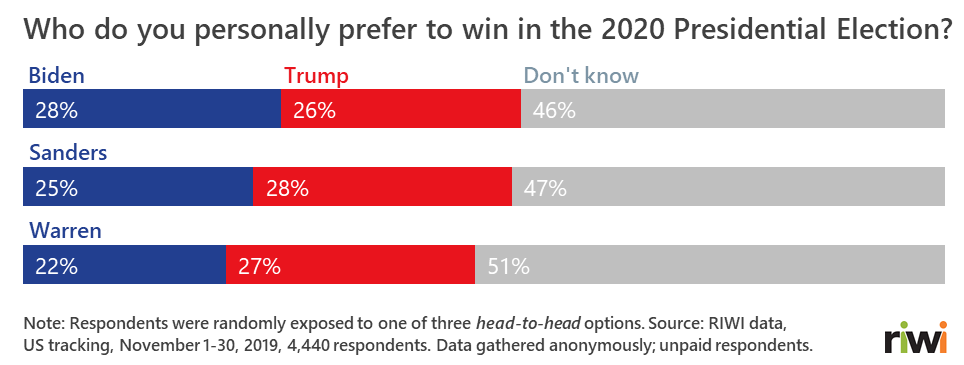By: Emily Kuzan
Featured chart: Republicans pull ahead in the Midwest in October/November
Few traditional polls have been reporting on the Midwest, yet the Midwestern states are crucial to predicting the outcome of the upcoming election. In 2016, Iowa, Wisconsin, Michigan, and Ohio all flipped Republican, helping to secure a win for President Trump in the Electoral College. In the upcoming election all eyes will be on the Midwest. We have been tracking which party people think will win in their state across the Midwest since September 19 and the data show that in mid-October the Republicans overtook the Democrats.

At the national level the election is still wide open, say RIWI crowd predictors
| Regardless of whom you support, which party do you think will win your state in the 2020 Presidential election? | ||
| Democratic Party | Republican Party | Don’t know |
| 25% | 24% | 51% |
| Source: RIWI data, US tracking, November 1-30, 2019, 5,453 respondents. Data gathered anonymously; unpaid respondents. | ||
- Asking who respondents think will win is more predictive than tallying individual preferences
- Among those who believe it is worth their time to vote, 28% don’t know which party will win in their state and the Democratic and Republican parties are tied at 36%
Senator Sanders pulls ahead of Senator Warren
When we randomly expose three leading Democratic presidential candidates in head-to-head matchups against President Trump we continue to see a high share of don’t know responses, narrowing slightly over the past month in Senator Sanders’ and Senator Warren’s matchups. Senator Sanders has also pulled ahead of Senator Warren, however he now loses when facing off with President Trump.

About 2020 In-Focus: RIWI Predictive Election Tracker
RIWI’s election tracker is different than traditional methods because it:
- Uses RIWI-powered technology that accurately predicted the 2016 Presidential Election
- It is continuous and real-time
- It reflects both engaged and politically disengaged populations, in contrast to traditional polls which typically capture engaged, often paid, populations
- It reflects views anonymously, reducing social desirability bias
Two of the “X-factors” that caused conventional polls to miss the 2016 election and that could manifest again in 2020 were 1) the underreflection of typically disengaged populations including those in the Midwest and 2) the “shy Trump voter” effect1. The RIWI patented methodology and technology platform addresses both X-factors.
From October 2019 to the November 2020 election, expect monthly updates on which party Americans think will win the Presidential Election, who Americans personally prefer to win the Presidential Election, and a new monthly insight depending on what the data reveal.
- Russonello, G. (2019, November 23). Four Problems With 2016 Trump Polling That Could Play Out Again in 2020. The New York Times. Retrieved from https://www.nytimes.com/2019/11/23/us/politics/2020-trump-presidential-polls.html